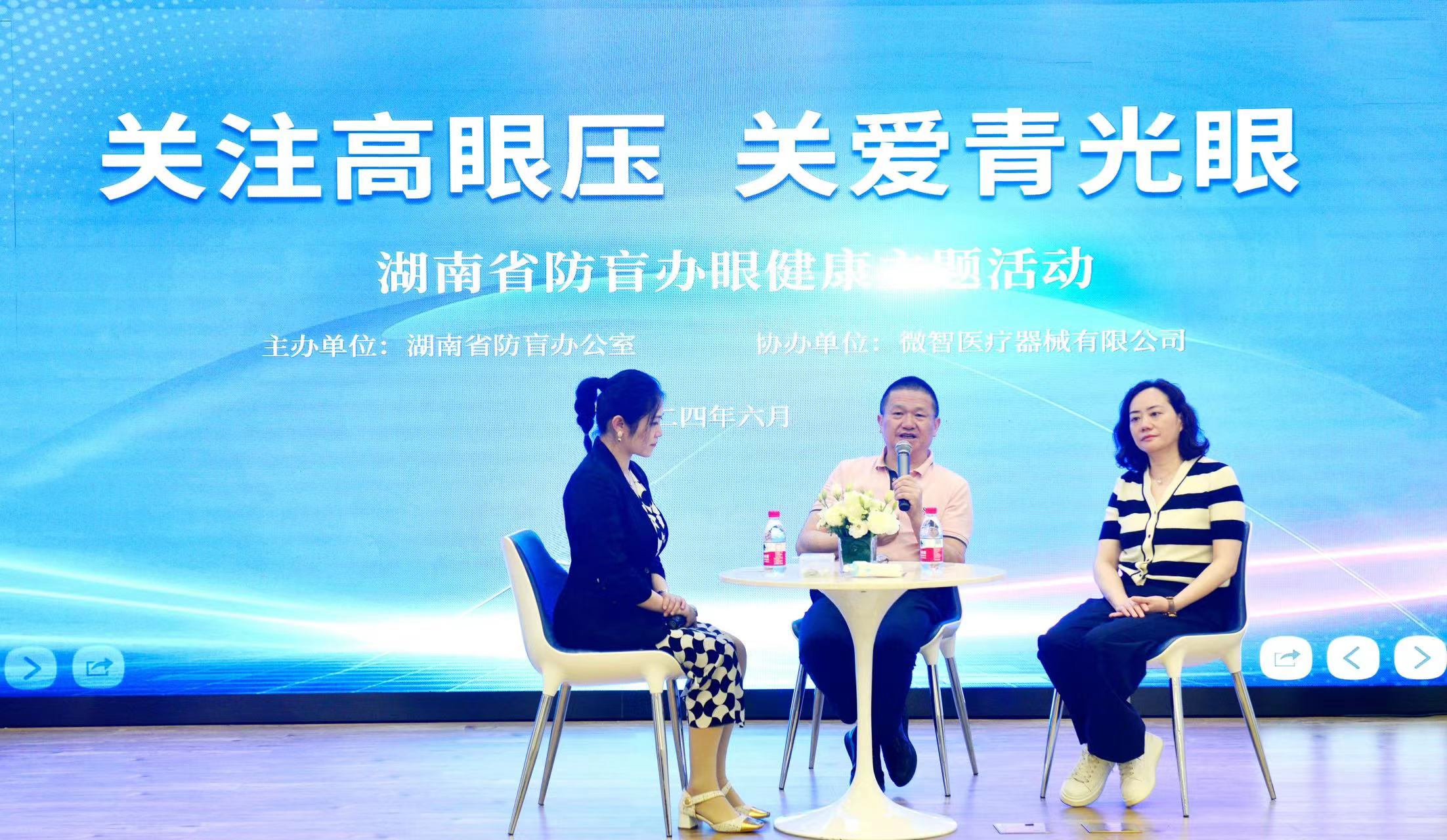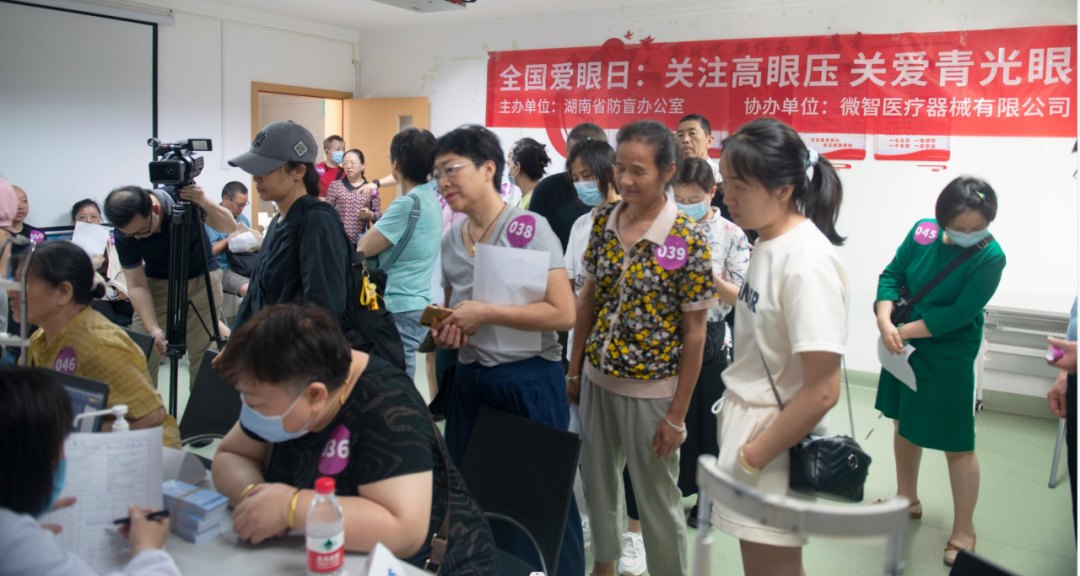【Editor’s note】With the rapid development of modern technology and the changes in working and living styles, various electronic devices have become essential daily tools. However, long-term excessive eye use and unreasonable habits for using eyes can easily lead to eye fatigue, abnormal intraocular pressure (IOP), visual impairment, and a significant increase in myopia and blindness rates. According to the statistics of the National Health Commission, as of 2022, there are more than 700 million myopia patients in China, and the overall myopia rate of children and adolescents nationwide is 53.6%. At the same time, the incidence of eye diseases such as abnormal IOP and glaucoma is increasing, and the harm to eye health is becoming more and more prominent. Eye health has become a major social issue that affects the healthy life of all people, and should attract the attention of the whole society. In order to call on the whole society to change the perception of eye health, Hunan Provincial Office for the Prevention of Blindness and IntelliMicro Medical Co., Ltd. jointly held a theme event on the occasion of the National Eye-care Day.

National Eye-Care Day is celebrated on June 6 every year. This festival was jointly established in 1996 by 12 ministries and commissions, including the Ministry of Health, the Ministry of Education, the Central Committee of the Communist Youth League of China and the China Disabled Persons’ Federation, with the aim of popularizing knowledge on using eyes scientifically, improving the eye health of adolescents, preventing eye diseases, and mobilizing all sectors of society to care for people’s eyes.
June 6, 2024 marks the 29th National Eye-Care Day with the theme of “Focus on Universal Eye Health”. In order to call on the whole society to change the perception of eye health, carry out regular monitoring of IOP, and achieve early detection, early finding and early treatment of IOP abnormalities, Hunan Provincial Office for the Prevention of Blindness and IntelliMicro Medical Co., Ltd. jointly held a theme event on the occasion of the National Eye-care Day.
Professor Duan Guoping, Executive Director of Hunan Provincial Office for the Prevention of Blindness, and Professor Li Ang, an ophthalmologist from Hunan Provincial People’s Hospital, were specially invited to carry out knowledge popularization and on-site Q&A. Some Changsha residents and glaucoma patients were invited to interact with the experts on the theme of “Focusing on Intraocular Pressure Caring for Glaucoma”, and raised a lot of questions about the prevention and treatment of intraocular hypertension and glaucoma.
“Despite the high blindness rate and great harm, glaucoma is generally preventable and controllable.” During the event, Professor Duan Guoping first explained in detail the causes, hazards and means of prevention and treatment of glaucoma, and shared many practical cases. He pointed out that due to the insidious onset of glaucoma, insufficient science popularization and attention, and few means of intraocular pressure detection, 90% of glaucoma patients in China do not know that they have glaucoma, and have never even heard of glaucoma. In fact, the blindness caused by glaucoma is preventable and controllable, if early finding, early treatment and household IOP monitoring are achieved, the blindness can be delayed, and the blindness rate can be greatly reduced.
Professor Duan Guoping pointed out that IOP control is of great significance for the prevention and treatment of glaucoma, and is the main means of optic nerve protection for glaucoma patients. The pressure of optical never can be released by lowering the IOP which can slow down the further damage of disease and delaying the progression. For glaucoma patients, the requirements for IOP control are more demanding and precise. Usually, doctors will set a target IOP control baseline according to the condition of the glaucoma patient, and control the IOP within this range to prevent or minimize the progression of glaucomatous optic nerve damage. The target IOP for patients with early glaucoma should be generally controlled within 18mmHg, patients with middle glaucoma should be within 15mmHg, and patients with late glaucoma should be within 12 mmHg. It is important to note that the above-mentioned target IOP values are not set in stone and need to be adjusted in real time according to the changes in the patient’s visual field and physical condition. Therefore, glaucoma patients need to monitor the IOP regularly. Only by lowering the IOP below the target IOP value can the further progression of visual field defects be stopped or mitigated, and the goal of delaying blindness can be achieved.

During the interaction, the two professors patiently answered the questions of the audience by combining with their professional knowledge and rich clinical experience, they not only shared a lot of knowledge about intraocular hypertension and glaucoma, but also pointed out many misunderstandings of the public’s perception on IOP detection, such as thinking that the results of a single outpatient IOP test can be used to determine the IOP, and as long as the IOP value of both eyes is within the normal IOP range (10-21mmHg), the IOP is normal.
They emphasized that due to the volatility and rhythmicity of IOP, a single outpatient IOP test could not fully reflect the true changes in IOP (According to relevant studies, if the measurement method of 12 times/day is selected as the golden standard, the false negative rate of diagnosis for 6 times/day is 44.44%, and the false negative rate of diagnosis for 4 times/day is 63.89%); at the same time, the normal IOP range should not only be within 10-21 mmHg, but also the difference between the two eyes should not exceed 5 mmHg, and the fluctuation of one eye should not exceed 8 mmHg in 24 hours. The above cognitive misunderstandings can easily lead to misjudgment, erroneous judgment and even missed diagnosis of IOP problems, which will delay the treatment. At present, the “24-hour golden standard IOP monitoring” is widely accepted and recommended in clinical practice, which can effectively reduce the rate of missed diagnosis.
The person in charge of IntelliMicro Medical Co., Ltd., the organizer of the event, introduced to the reporters that in response to the Chinese market demand, IntelliMicro has launched a new type of rebound tonometer — IntelliMicro® Rebound Tonometer by taking advantage of the Chinese and foreign technological resources. The product adopts disposable sterile probe detection, no anesthesia is required, the accuracy of intraocular pressure measurement benchmarked with the golden standard is ± 1.2mmHg, the operation is simple and convenient, easy to carry, no professional training or third-party operation is required, IOP detection can be carried out at any time, which solves the pain points that the existing domestic IOP testing equipment cannot support medical/household use and self-testing at the same time, and cannot achieve 24-hour golden standard IOP detection. It fills the gap of domestic self-test tonometer for household use, and provides a real-time and convenient IOP detection tool for patients and doctors.
At the end of the event, the two experts also reminded everyone again, whether it is intraocular hypertension or glaucoma, everyone must carefully follow the doctor’s instructions, treat it scientifically, start from ourselves, start from others, start from the daily life, do a good job of being the first person to protect our eye health, and regularly conduct IOP testing for our own eye health to prevent a “minor disease” from becoming a “major disaster”.

Before the event, Hunan Provincial People’s Hospital and Hunan Provincial Office for the Prevention of Blindness, together with IntelliMicro Medical Co., Ltd., carried out a free clinic activity at the headquarters of Hunan Provincial People’s Hospital on May 28, providing free vision tests, visual acuity examinations, IOP measurements, etc., and popularized intraocular hypertension, glaucoma and other related ophthalmological knowledge.
In the future, IntelliMicro will work with Hunan Provincial Office for the Prevention of Blindness to carry out more public benefit activities for eye health, introduce and popularize the symptoms, risks, prevention and control of eye diseases such as glaucoma and intraocular hypertension to the public from multiple dimensions and perspectives, and improve the awareness of eye health, prevention and control in the whole society.


